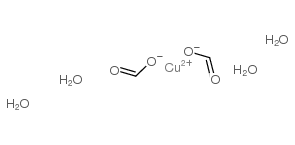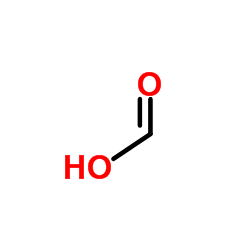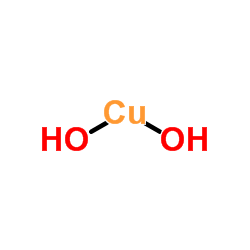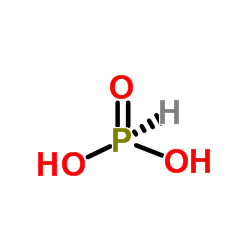544-19-4
| Name | Formic acid, copper(2+) salt (1_1) |
|---|---|
| Synonyms |
Ameisensaeure,Kupfer(II)-formiat
coppper(II) formate formic acid copper Kupfer(II)-formiat-4-hydrat formicacid,copper(2++)salt formicacid,copper(2+)salt(1:1) cupric formate MFCD00167128 COPPER (II) FORMATE cupricdiformate copper diformate formic acid,copper (II)-formate COPPER FORMATE |
| Density | 1.831 g/cm3 |
|---|---|
| Boiling Point | 100.6ºC at 760 mmHg |
| Melting Point | 130ºC |
| Molecular Formula | CH2CuO2++ |
| Molecular Weight | 109.57100 |
| Flash Point | 29.9ºC |
| Exact Mass | 108.93500 |
| PSA | 37.30000 |
| LogP | 0.33420 |
| Water Solubility | 12.5g/100mL H2O [CRC10]; insoluble most organic solvents [MER06] |
|
Section 1: Product Identification Chemical Name:Copper (II) formate hydrate CAS Registry Number:544-19-4 Formula:Cu(OOCH)2.XH2O EINECS Number:none Chemical Family:salt of an organic acid Synonym:Formic acid, copper (+2) salt
Section 2: Composition and Information on Ingredients IngredientCAS NumberPercentACGIH (TWA)OSHA (PEL) Title Compound544-19-4100%1mg/m3 (as Cu)1mg/m3 (as Cu) Section 3: Hazards Identification Emergency Overview:Irritating to the skin, eyes and respiratory tract. Primary Routes of Exposure:Ingestion, inhalation Eye Contact:Causes slight to mild irritation of the eyes Skin Contact:Causes slight to mild irritation of the skin. Inhalation:The material is a fine powder. Irritating to the nose, mucous membranes and respiratory tract. Ingestion:Ingestion of copper compounds may lead to vomiting, exhaustion, anemia, convulsions and coma. Acute Health Affects:Irritating to skin, eyes and respiratory tract. Chronic Health Affects:No information available on long-term chronic effects. NTP:No IARC:No OSHA:No SECTION 4: First Aid Measures Immediately flush the eyes with copious amounts of water for at least 10-15 minutes. A victim may need Eye Exposure: assistance in keeping their eye lids open. Get immediate medical attention. Wash the affected area with water. Remove contaminated clothes if necessary. Seek medical assistance if Skin Exposure: irritation persists. Remove the victim to fresh air. Closely monitor the victim for signs of respiratory problems, such as difficulty Inhalation: in breathing, coughing, wheezing, or pain. In such cases seek immediate medical assistance. Seek medical attention immediately. Keep the victim calm. Give the victim water (only if conscious). Induce Ingestion: vomiting only if directed by medical personnel. SECTION 5: Fire Fighting Measures Flash Point:no data Autoignition Temperature:none Explosion Limits:none Extinguishing Medium:carbon dioxide, foam or dry powder If this product is involved in a fire, fire fighters should be equipped with a NIOSH approved positive pressure Special Fire Fighting Procedures: self-contained breathing apparatus and full protective clothing. Hazardous Combustion andIf involved in a fire this material may emit irritating fumes. Decomposion Products: Unusual Fire or Explosion Hazards: No unusual fire or explosion hazards. SECTION 6: Accidental Release Measures Spill and Leak Procedures:Small spills can be mixed with vermiculite or sodium carbonate and swept up. SECTION 7: Handling and Storage Handling and Storage:Store in a tightly sealed container. Handle the material in a ventilated area. SECTION 8: Exposure Controls and Personal Protection Eye Protection:Always wear approved safety glasses when handling a chemical substance in the laboratory. Skin Protection:Wear protective clothing and gloves. Ventilation:Material may form a fine dust. If possible, handle the material in an efficient fume hood. If ventilation is not available a respirator should be worn. The use of respirators requires a Respirator Respirator: Protection Program to be in compliance with 29 CFR 1910.134. Ventilation:Material may form a fine dust. If possible, handle the material in an efficient fume hood. Additional Protection:No additional protection required. SECTION 9: Physical and Chemical Properties Color and Form:green to blue pwdr. Molecular Weight:153.55 Melting Point:no data Boiling Point:no data Vapor Pressure:not applicable Specific Gravity:1.831 Odor:none Solubility in Water:slightly soluble SECTION 10: Stability and Reactivity Stability:air and moisture stable solid Hazardous Polymerization:no hazardous polymerization Conditions to Avoid:none Incompatibility:Oxidizing agents Decomposition Products:carbon dioxide, carbon monoxide, organic fumes, and copper salts. SECTION 11: Toxicological Information RTECS Data:No specific information available on this product. Carcinogenic Effects:No data available Mutagenic Effects:No data available Tetratogenic Effects:No data available SECTION 12: Ecological Information Ecological Information:No information available SECTION 13: Disposal Considerations Disposal:Dispose of according to local, state and federal regulations. SECTION 14: Transportation Shipping Name (CFR):Non-hazardous Hazard Class (CFR):NA Additional Hazard Class (CFR):NA Packaging Group (CFR):NA UN ID Number (CFR):NA Shipping Name (IATA):Non-hazardous Hazard Class (IATA):NA Additional Hazard Class (IATA):NA Packaging Group (IATA):NA UN ID Number (IATA):NA SECTION 15: Regulatory Information TSCA:Listed in the TSCA inventory. SARA (Title 313):See Category Code N100 for reporting. Second Ingredient:none SECTION 16 - ADDITIONAL INFORMATION N/A |
| Hazard Codes | Xn,N |
|---|---|
| Risk Phrases | R20/21/22 |
| Safety Phrases | 22-36/37/39 |
|
~% 
544-19-4 |
| Literature: Helvetica Chimica Acta, , vol. 17, p. 1094 - 1119 |
|
~% 
544-19-4 |
| Literature: Helvetica Chimica Acta, , vol. 13, p. 978 - 1006 |
|
~% 
544-19-4 |
| Literature: Russian Journal of Inorganic Chemistry (Translation of Zhurnal Neorganicheskoi Khimii), , vol. 24, p. 1202 - 1205 Zhurnal Neorganicheskoi Khimii, , vol. 24, p. 2172 - 2175 |
|
~% 
544-19-4 |
| Literature: US2004/127751 A1, ; Page 4 ; |
|
~% 
544-19-4 |
| Literature: Russian Journal of Inorganic Chemistry (Translation of Zhurnal Neorganicheskoi Khimii), , vol. 24, p. 213 - 216 Zhurnal Neorganicheskoi Khimii, , vol. 24, p. 384 - 388 |
| Precursor 4 | |
|---|---|
| DownStream 6 | |







